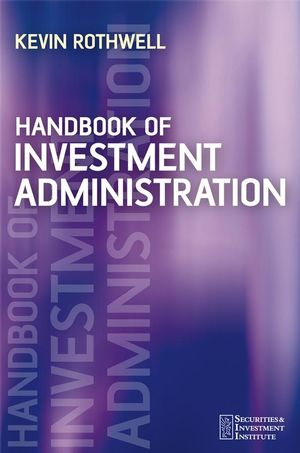Handbook of Investment AdministrationISBN: 978-0-470-03362-3
Paperback
520 pages
November 2007
 |
||||||
Introduction.
PART I: INTRODUCTORY ELEMENTS.
1. WEALTH MANAGEMENT.
1.1 Introduction.
1.2 Wealth management market.
1.3 Types of business.
1.4 Investment services and products.
1.5 Investment firms.
1.6 Investment administration.
PART II: INVESTMENT ADMINISTRATION.
2. NEW AND CLOSING BUSINESS.
2.1 Introduction.
2.2 New business.
2.3 Client types.
2.4 Know your customer.
2.5 Agreements.
2.6 Account opening.
2.7 Money laundering.
2.8 Validating the assets.
2.9 Transferring assets.
2.10 Raising assets.
2.11 Closing business and transfers.
2.12 Death of a client.
3. TRADING.
3.1 Introduction.
3.2 Stock market developments.
3.3 Equity trading.
3.4 Bond trading.
3.5 Regulation.
4. SETTLEMENT.
4.1 Introduction.
4.2 Fundamentals of settlement.
4.3 Settlement process.
4.4 UK settlement.
4.5 International settlement.
5. CORPORATE ACTIONS.
5.1 Introduction.
5.2 Corporate actions industry.
5.3 Types of event.
5.4 Private client corporate action processing.
5.5 Corporate events.
5.6 Income events.
PART III: OTHER CONSIDERATIONS.
6. CUSTODY.
6.1 Introduction.
6.2 Protection of client assets.
6.3 Segregation of safe custody assets..
6.4 Use of a custodian.
6.5 Nominee companies.
6.6 Global custodians.
6.7 Selecting a custodian.
6.8 Custody agreements and SLAs.
6.9 Reviewing the suitability of custodians.
7. TAX.
7.1 Introduction.
7.2 Income tax.
7.3 Tax treatment of dividends.
7.4 Capital gains tax.
7.5 Residence and domicile.
7.6 Withholding tax.
7.7 EU savings directive.
8. POWERS OF ATTORNEY.
8.1 Introduction.
8.2 Background.
8.3 Parties and terminology.
8.4 Enduring power of attorney.
8.5 Receiverships.
8.6 Mental capacity act 2005.
8.7 Administration.
9. OUTSOURCING.
9.1 Introduction.
9.2 Development of outsourcing.
9.3 Risks associated with outsourcing.
9.4 Regulatory principles.
PART IV: INVESTMENT ACCOUNTS AND PRODUCTS.
10. INDIVIDUAL SAVINGS ACCOUNTS (ISAS).
10.1 Introduction.
10.2 Development of ISAs and PEPs.
10.3 Organisation and regulation.
10.4 Individual savings accounts.
10.5 Allowable investments.
10.6 New and closing business.
10.7 Voids and repairs.
10.8 Residence.
10.9 Investor reporting.
10.10 Reform of the ISA regime.
11. COLLECTIVE INVESTMENT SCHEMES.
11.1 Introduction.
11.2 Regulation of UK funds.
11.3 Types of UK funds.
11.4 Fund administration .
11.5 Pricing.
11.6 Dealing and settlement.
11.7 Share register.
11.8 Dividend and interest distributions.
11.9 Investor reporting.
12. TRUSTS.
12.1 Introduction.
12.2 Development of trusts.
12.3 Fundamentals of trusts.
12.4 Investment administration.
13. CHARITIES.
13.1 Introduction.
13.2 What is a charity?
13.3 Legal background to investment by charities.
13.4 Trustee investment powers and duties.
13.5 Investment policy.
13.6 Appointing an investment manager.
13.7 Common investment funds.
13.8 Use of nominees and custodians.
14. SELF-INVESTED PERSONAL PENSIONS.
14.1 Introduction.
14.2 Development of SIPPs.
14.3 What is a SIPP?
14.4 Setting up a SIPP.
14.5 Eligibility and contributions.
14.6 Permitted investments.
14.7 Benefits.
15. DERIVATIVE PRODUCTS.
15.1 Introduction.
15.2 Types of derivatives.
15.3 Uses of derivates.
15.4 Derivatives markets.
15.5 Structured products.
15.6 Covered warrants.
15.7 Exchange traded commodities.
15.8 Contracts for difference.
Glossary.
Bibliography.
Reading Material.
Index.



